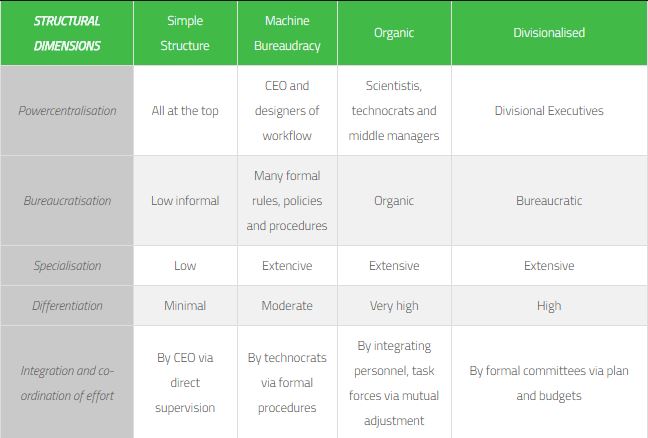
Elements of Classifying Organisation Structures:
| STRUCTURAL DIMENSIONS | Simple Structure | Machine Bureaudracy | Organic | Divisionalised |
| Powercentralisation | All at the top | CEO and designers of workflow | Scientistis, technocrats and middle managers | Divisional Executives |
| Bureaucratisation | Low informal | Many formal rules, policies and procedures | Organic | Bureaucratic |
| Specialisation | Low | Extencive | Extensive | Extensive |
| Differentiation | Minimal | Moderate | Very high | High |
| Integration and co-ordination of effort | By CEO via direct supervision | By technocrats via formal procedures | By integrating personnel, task forces via mutual adjustment | By formal committees via plan and budgets |
| Information systems | Crude, informal | Cost controls and budgets | Informal scanning, open communications | Managementinformationsystems and profit centres |
Principle:
Classifies simple, machine bureaucracy, organic and divisionalised organisational structures in relation to Structural & Environmental dimensions
Issues:
Generic competitive strategies
[supsystic-tables id=’6′]
| STRUCTURE | RATIONALE | STRATEGY |
| Simple structure | Provides quality, convenience and service | Marketing differentiation |
| Avoids competition with large palyers; builds of advantages of small size | Niche differentiation | |
| Machine bureaucracy | Can achieve economies of scale | Cost leadership |
| Matches stable environment | ||
| Only suitable if differentiation | Marketing differentiation | |
| Does not disrupt efficiency, so, e.g. advertising/service suitable but not customisation/tailoring | ||
| Organic structure | Flexible, innovative structure | Innovative differentiation |
| Only if niche is big enough to exploit the potential of the technology | Niche differentiation | |
| Divisionalised structure | Decentralised, financial control style cosistent with cost leadership if businesses are unrelated | Cost leadership |
| Coordinated, integrated style consistent if businesses are related | ||
| Allows greater tailoring to market needs | Marketing differentiation |
Applications:
To determine organisational structure fit






